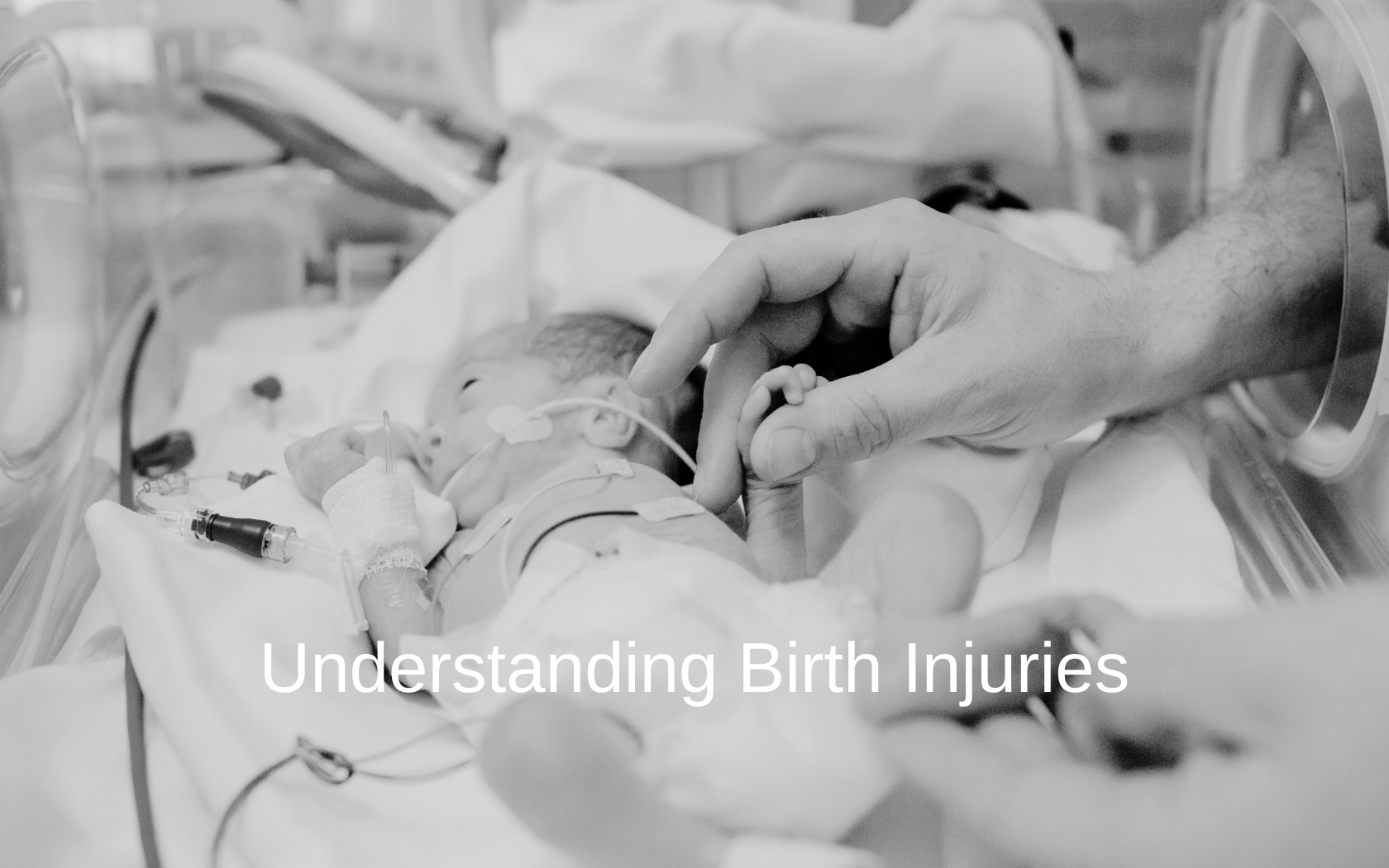Determining the causes of birth injuries is something like a game of Clue. Each piece of evidence leads to a potential culprit. Medical professionals must put their magnifying glasses on all the circumstances surrounding birth to uncover the sequence of events that may have contributed to the injury.
Could medical negligence be the missing piece in the puzzle of what went wrong? It’s possible! But human error isn’t the only cause of birth injuries. Sometimes the perpetrator is an underlying health issue or an unpreventable act of fate.
In this article, we’ll discuss some of the most common causes of birth injuries. If you believe a doctor’s mistake caused your child’s injury, call our lawyers. We’ll clue you in to any errors that were made and tell you whether we believe you have a case.

What are Birth Injuries?
Birth injuries are different from birth defects. Birth injuries happen during the labor and delivery process. Birth defects are present before birth, and result from genetic or environmental factors.
Birth injuries can range from mild to severe. They can affect various parts of a baby’s body. The most commonly affected areas are the head, shoulders, and nerves.
Some of the most common birth injuries include:
- Cerebral palsy
- Caput Succedaneum: swelling of the soft tissues of the baby’s scalp.
- Brachial plexus injuries, including Erb’s palsy
- Fractures, especially of the collarbone
- Cephalohematoma: bleeding between the skull and the periosteum (the membrane covering the bones) of the baby’s head.
- Asphyxia (oxygen deprivation) that causes brain and/or organ damage
- Facial nerve injury
- Hypoxic-Ischemic Encephalopathy (HIE): a brain injury caused by oxygen deprivation and reduced blood flow to the brain during childbirth.
Some birth injuries heal on their own or with medical intervention. But others can have long-term consequences. Babies with serious birth injuries often need life-long treatment and support.
What are Some Common Causes of Birth Injuries?
The causes of birth injuries fall into a few main categories:
- Physical factors, such as the baby’s size and position, and the mother’s pelvic structure.
- Medical interventions, such as using forceps or vacuum to aid delivery.
- Fetal distress. The baby experiences distress during labor due to prolonged labor, lack of oxygen, or other reasons.
- Medical conditions in the mother or baby, such as macrosomia (excessive fetal growth) or gestational diabetes.
- Negligence or Medical Errors, such as misdiagnosing conditions, improper administration of medications (like labor-inducing oxytocin), or failing to monitor mother and baby during labor.
According to an article in the Merck Manual, “natural forces of labor and delivery” are the most common causes of birth injuries. This is because delivery itself, even without complications, can be difficult. When delivery is made even more complicated by abnormal fetal position, fetal size, or other factors, injuries are much more likely to occur.

Risk Factors for Birth Injuries
Certain health conditions in the mother or baby can raise the risk of birth injuries. They might contribute to the causes of birth injuries by affecting the pregnancy, labor, or delivery process.
For example, conditions like gestational diabetes or preeclampsia can impact fetal growth and development. They can increase the likelihood of complications during birth.
Also, the mother might transmit infections to the baby during pregnancy or delivery. Cytomegalovirus (CMV) and syphilis are examples of dangerous infections that can cause birth injuries.
Other factors that can increase the risk of birth injury include:
- Advanced maternal age
- Obesity
- Multiple pregnancies (such as having twins or triplets)
- The mother uses illicit drugs, smokes, or drinks alcohol while pregnant
- The baby is larger than average (macrosomia)
- Preterm birth (before 37 weeks of gestation)

How Can I Determine the Cause of a Birth Injury?
Determining the cause of a birth injury involves several critical steps. First, speak to your doctor to obtain an initial diagnosis and understand the potential factors involved.
After that, you might want to get a second opinion. This can ensure an accurate diagnosis. You can also explore different perspectives on the cause of the birth injury.
Birth injuries are sometimes unavoidable due to natural complications. But others may result from preventable factors or medical errors. If you suspect that medical malpractice might be involved, you should consult with a lawyer who specializes in birth injuries.
An attorney can help investigate the circumstances surrounding the injury, review medical records, and assess whether your providers met the standard of care. Like a game of Clue, it may take some time to unravel the mystery. But a lawyer’s thorough, comprehensive approach can help you determine the cause of the birth injury and take appropriate action if they find evidence of negligence.
Common Causes of Birth Injuries FAQ’s
The most common birth injury is minor swelling and bruising of a baby’s scalp. This is known as caput succedaneum. It happens when pressure on the baby’s head during delivery causes the soft tissues on the baby’s scalp to swell. Other fairly common birth injuries include cephalohematoma (when blood collects between a baby’s scalp and the skull bone) and fractured collarbones.
The most common cause of birth trauma is difficult or prolonged labor and delivery. Factors that can make labor long and difficult include:
– Macrosomia (the baby is larger than average)
– Premature birth
– Abnormal birth positions (such as feet-first)
– Mother has a narrow pelvis
– Mother has certain health conditions that make delivery more difficult.
These factors can lead to increased pressure on the baby during delivery, which can result in injuries such as bruising, fractures, and nerve damage. Also, if a doctor decides to use forceps or vacuum extraction to pull the baby out, there’s a higher risk of birth trauma.
According to the World Health Organization (WHO), the top causes of maternal injury are:
– Postpartum hemorrhage (excessive blood loss)
– Infection
– High blood pressure
– Unsafe abortion
– Obstructed labor (when the baby can’t progress through the birth canal because of pelvic abnormalities, being in the wrong position, or other reasons).
Other causes of maternal injury include medical errors, misuse of forceps or vacuum extractors, C-section complications, and placental complications.




